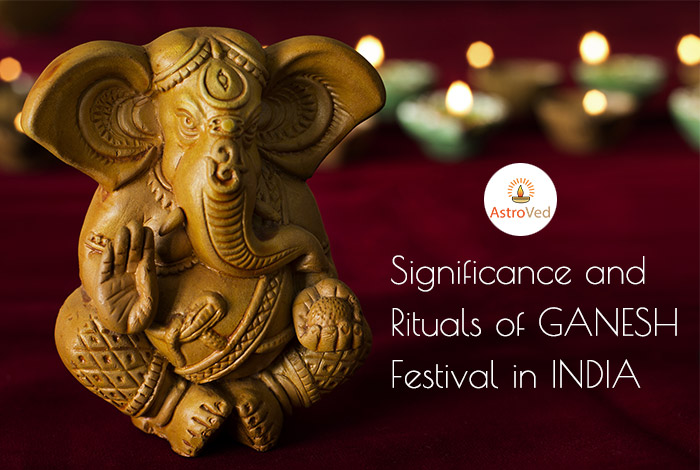Ganesh Chaturthi is a very popular Hindu festival. It is also called Vinayaka Chaturthi or Vinayaka Chavithi and is grandly celebrated throughout India, especially in Maharashtra. This ten-day festival begins on the fourth day (Shukla Chaturthi) and ends on the fourteenth day of the waxing moon called Anant Chaturdashi in Bhadrapada month (mid-August-mid September). Ganesh Chaturthi festival celebrates the birth of Lord Ganesha, who is the son of Lord shiva and goddess parvati. Ganesha is the elephant-headed God of wealth, good fortune and auspicious beginnings.

Ganesh Chaturthi Rituals
Significance of Ganesh Chaturthi:
The festival was actually begun by Chatrapati Shivaji Maharaj, the founder of the Maratha Empire. He was a very brave warrior. The Peshwas worshipped and celebrated Ganesh Chaturthi in Pune, their state capital, as Ganesha was their family god. After the decline of the Peshwas, this festival lost state patronage and people celebrated it at home only. After some time, the celebration was revived again by the freedom fighter, Lokmanya Tilak, as a state-sponsored affair. He used it to disseminate the message of freedom as he wanted to get public support for the national freedom movement in India. For this reason, it is celebrated with much vigor and enthusiasm in Maharashtra.
Lord Ganesha is associated with prosperity and fortune. One often finds his image on invitation cards for wedding ceremonies. Small Ganesha idols are also found at the entrance of homes. It is believed that this helps positive vibrations to enter the house and bring good fortune to those who live in the house.
Ganesha’s Birth
Stories related to the birth of Ganesha can be found in the book, Brahma Vivartha Purana, under the segment, Ganesha Khanda. There are many such stories narrating the birth of the God of Supreme Self, Lord Ganesha, as he is identified with the Supreme Self. He is regarded as the God of spiritual knowledge, good luck and prosperity. The most popular of these stories is that of Goddess Parvati who created a human figure out of sandalwood and made him stand guard to protect her privacy when she went to have a bath.
The Symbolism behind Ganesha
Lord Ganesha has the head of an elephant. This symbolizes great wisdom which is caused by “manana” or independent thinking. ‘Manana’ in turn arises from the process of “shravana” or intake of spiritual knowledge. This is represented by the deity’s large ears. The god’s well-developed trunk represents wisdom and the intellect of a perfectionist. The Lord’s vahan or vehicle is a mouse which represents conquest of the ego. The food offered to him at his feet symbolizes power and material wealth. The objects he holds in his hand too signify many things. For instance, the rope signifies spiritual knowledge, the axe, annihilation of desire, modak represents happiness and the lotus symbolizes the divine state of self-realization.
Ganesh Chaturthi Rituals
Ganesh Chaturthi Festival is celebrated grandly all over India. People begin the festival by cleaning and decorating the houses. Artisans begin to craft marvellous clay idols months before the festival commences.
The festival has many rituals which include chanting mantras, slokas and devotional songs. Arti (circulation of an earthen lamp by the priest) is done with great devotion before the deity. Delicacies dear to Ganesha like Modak and Karanji are prepared as offerings. Modak is made of steamed rice flour parcels which hold a stuffing of jaggery, coconut, etc. Other delicacies include Payasam, barfi, Pedha, Sabudana, puliyodarai, laddoo and Puliyodarai (tamarind rice). Songs, dances, theatrical performances, bursting of firecrackers, etc., are all part of the festivities. They come to an end with the Visarjan or immersion of Lord Ganesha idol in the ocean, rivers and lakes.
The Rituals of Ganesh Chaturthi:
Ganesh Chaturthi rituals are observed for ten days beginning on the fourth day of the waxing moon (Shukla Chaturthi) and ending on the fourteenth day of this period. (Anant Chaturdashi) in the month of Bhadrapada. Preparations begin many months before the festival. Lighting arrangements will be made to illuminate the city, and skilled artisans start to craft clay idols and others construct pandals. On the first day of the festival, devotees take bath and wear new clothes before they worship the deity.
After placing the idol on a pedestal, they decorate it with flower garlands and sandalwood paste. A kalash (pot) with rice or holy water is placed before the deity. This is known as Purna Kumbha. The priest performs prayers to infuse the idol with life. This is called Pranaprathisthha. During this time, he chants slokas and mantras. Once this is completed, Shodashopachara is performed. This is a method of offering prayer in sixteen ways. Then the priest offers Arti and chants 108 names of the lord,along with slokas and mantras.The offerings for Lord Ganesha include Modak, Pedha, Sabudana laddoo, Badam laddoo, Puran Poli, Karanji, etc.
By worshipping Lord Ganesha on this day, people invoke his blessings and thereby attain spiritual knowledge, success wisdom and success in all their endeavors. Observing Ganesh Chaturthi is believed to bring prosperity and good fortune.

